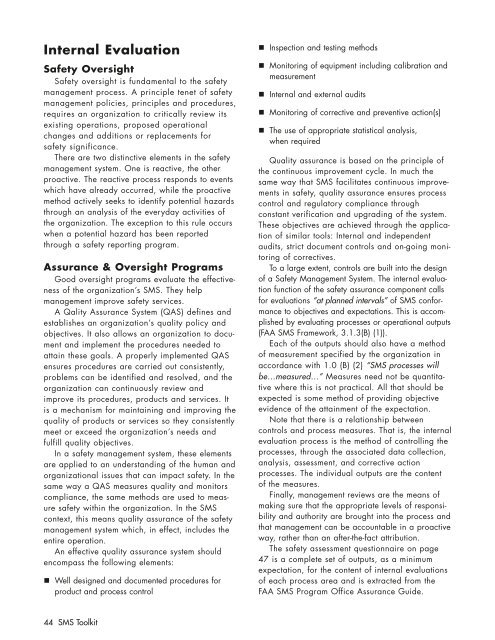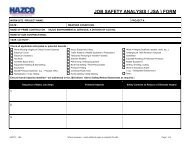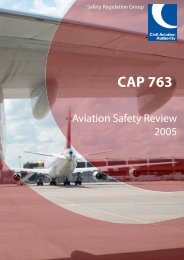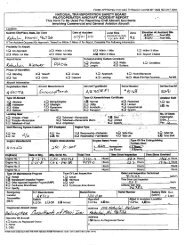International Helicopter Safety Team Safety Management System Toolkit
IHST - Safety Management Toolkit - Skybrary
IHST - Safety Management Toolkit - Skybrary
- No tags were found...
Create successful ePaper yourself
Turn your PDF publications into a flip-book with our unique Google optimized e-Paper software.
Internal Evaluation<br />
<strong>Safety</strong> Oversight<br />
<strong>Safety</strong> oversight is fundamental to the safety<br />
management process. A principle tenet of safety<br />
management policies, principles and procedures,<br />
requires an organization to critically review its<br />
existing operations, proposed operational<br />
changes and additions or replacements for<br />
safety significance.<br />
There are two distinctive elements in the safety<br />
management system. One is reactive, the other<br />
proactive. The reactive process responds to events<br />
which have already occurred, while the proactive<br />
method actively seeks to identify potential hazards<br />
through an analysis of the everyday activities of<br />
the organization. The exception to this rule occurs<br />
when a potential hazard has been reported<br />
through a safety reporting program.<br />
Assurance & Oversight Programs<br />
Good oversight programs evaluate the effectiveness<br />
of the organization’s SMS. They help<br />
management improve safety services.<br />
A Qality Assurance <strong>System</strong> (QAS) defines and<br />
establishes an organization’s quality policy and<br />
objectives. It also allows an organization to document<br />
and implement the procedures needed to<br />
attain these goals. A properly implemented QAS<br />
ensures procedures are carried out consistently,<br />
problems can be identified and resolved, and the<br />
organization can continuously review and<br />
improve its procedures, products and services. It<br />
is a mechanism for maintaining and improving the<br />
quality of products or services so they consistently<br />
meet or exceed the organization’s needs and<br />
fulfill quality objectives.<br />
In a safety management system, these elements<br />
are applied to an understanding of the human and<br />
organizational issues that can impact safety. In the<br />
same way a QAS measures quality and monitors<br />
compliance, the same methods are used to measure<br />
safety within the organization. In the SMS<br />
context, this means quality assurance of the safety<br />
management system which, in effect, includes the<br />
entire operation.<br />
An effective quality assurance system should<br />
encompass the following elements:<br />
Well designed and documented procedures for<br />
product and process control<br />
Inspection and testing methods<br />
Monitoring of equipment including calibration and<br />
measurement<br />
Internal and external audits<br />
Monitoring of corrective and preventive action(s)<br />
The use of appropriate statistical analysis,<br />
when required<br />
Quality assurance is based on the principle of<br />
the continuous improvement cycle. In much the<br />
same way that SMS facilitates continuous improvements<br />
in safety, quality assurance ensures process<br />
control and regulatory compliance through<br />
constant verification and upgrading of the system.<br />
These objectives are achieved through the application<br />
of similar tools: Internal and independent<br />
audits, strict document controls and on-going monitoring<br />
of correctives.<br />
To a large extent, controls are built into the design<br />
of a <strong>Safety</strong> <strong>Management</strong> <strong>System</strong>. The internal evaluation<br />
function of the safety assurance component calls<br />
for evaluations “at planned intervals” of SMS conformance<br />
to objectives and expectations. This is accomplished<br />
by evaluating processes or operational outputs<br />
(FAA SMS Framework, 3.1.3(B) (1)).<br />
Each of the outputs should also have a method<br />
of measurement specified by the organization in<br />
accordance with 1.0 (B) (2) “SMS processes will<br />
be…measured…” Measures need not be quantitative<br />
where this is not practical. All that should be<br />
expected is some method of providing objective<br />
evidence of the attainment of the expectation.<br />
Note that there is a relationship between<br />
controls and process measures. That is, the internal<br />
evaluation process is the method of controlling the<br />
processes, through the associated data collection,<br />
analysis, assessment, and corrective action<br />
processes. The individual outputs are the content<br />
of the measures.<br />
Finally, management reviews are the means of<br />
making sure that the appropriate levels of responsibility<br />
and authority are brought into the process and<br />
that management can be accountable in a proactive<br />
way, rather than an after-the-fact attribution.<br />
The safety assessment questionnaire on page<br />
47 is a complete set of outputs, as a minimum<br />
expectation, for the content of internal evaluations<br />
of each process area and is extracted from the<br />
FAA SMS Program Office Assurance Guide.<br />
44 SMS <strong>Toolkit</strong>







